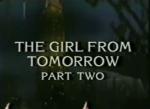
 The Girl from Tomorrow Part II : Tomorrow's End
series - publisher
children's
science fiction
The Girl from Tomorrow Part II : Tomorrow's End
series - publisher
children's
science fiction

 The Girl from Tomorrow Part II : Tomorrow's End
series - publisher
children's
science fiction
The Girl from Tomorrow Part II : Tomorrow's End
series - publisher
children's
science fiction
A sequel to The Girl from Tomorrow, The Girl from Tomorrow Part II: Tomorrow's End begins with Alana returning to her own time with Jenny, who has been badly wounded and needs the advanced medical treatment Alana's people can offer. But with both Silverthorn and Jenny out of their own time, Alana's people begin to fear that their time travel experiments are affecting the course of history. They restore both Silverthorn and Jenny to their own times and return once again to 3000AD--to find it a radioactive wasteland. Alana must trace the cause of the disaster, which leads her to 2500AD and Draco, malevolent controller of GlobeCorp, the company that controls all resources in the polluted, unhappy dystopia that is 2500AD.
Likes its predecessor and the later programs Spellbinder and Spellbinder II: Land of the Dragon Lord, The Girl from Tomorrow II was a collaboration between Mark Shirrefs and John Thomson, although in this case Thomson is only credited with the story and Shirrefs with the actual screenplays.
This chapter explores apocalypse in children's literature with reference to literary attitudes to children, nature and dystopia. Examinations of works by Lee Harding, Victor Kelleher, and John Marsden then focus on how these writers adapt apocalyptic themes for a juvenile audience. Their novels display tyranny, large-scale catastrophe, invasion, and children in danger, and their apocalyptic settings reveal anxieties about isolation, invasion, Indigenous land rights and colonization. (108)
This chapter explores apocalypse in children's literature with reference to literary attitudes to children, nature and dystopia. Examinations of works by Lee Harding, Victor Kelleher, and John Marsden then focus on how these writers adapt apocalyptic themes for a juvenile audience. Their novels display tyranny, large-scale catastrophe, invasion, and children in danger, and their apocalyptic settings reveal anxieties about isolation, invasion, Indigenous land rights and colonization. (108)